AMD Radeon HD 7950 Review Feat. Sapphire & XFX: Sewing Up The High-End Market
by Ryan Smith on January 31, 2012 9:02 AM ESTPower, Temperature, & Noise
As always, we wrap up our look at a new video card with a look at the physical performance attributes: power consumption, temperatures, and noise. With the 7970 we saw what is possible with Tahiti when AMD is trying to maximize their performance, but how will things stack up with the lower power 7950? Let’s find out.
Please note that we’ve decided to include our reference 7950 in these charts, even though none of AMD’s partners will be shipping a card in this exact configuration. Typically we wouldn’t do this, but as our partner cards are overclocked it’s the only stock performance card we have. Furthermore it provides an interesting contrast to the 7970, since they’re built on the same hardware. With that said, the Sapphire and XFX cards are far more representative of the cooling performance you’ll see with retail cards.
| Radeon HD 7900 Series Voltages | |||||
| Ref 7970 Load | Ref 7950 Load | XFX 7950 Black Edition DD | Sapphire HD 7950 Overclock Edition | ||
| 1.17v | 1.093v | 1.093v | 0.993v | ||
Since the launch of the 7970 we’ve finally seen the release of tools that can read the VIDs of Tahiti GPUs. For our review we have four 7950s in our hands, and one of them is not like the others. Both of our AMD cards and our XFX card have a VID of 1.093v, however the Sapphire card is significantly lower. So low that we thought this was an error and went through 3 different tools just to be sure it wasn’t. Sure enough, our Sapphire 7950 does indeed ship at 0.993v, roughly 0.1v below our other 7950s and lower than what we thought Tahiti could operate at. The fact that the Sapphire is overclocked makes this all the more impressive, and we’ll see how this plays out in a moment.
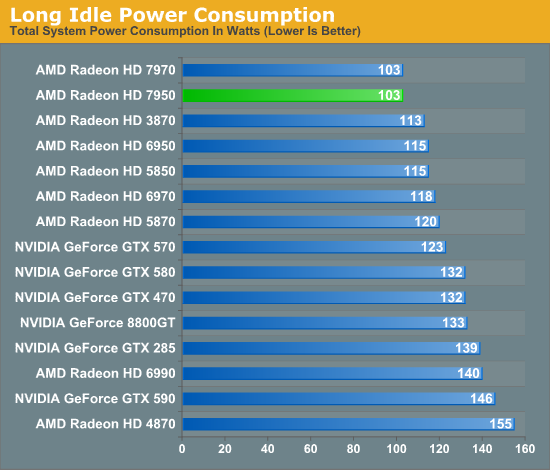
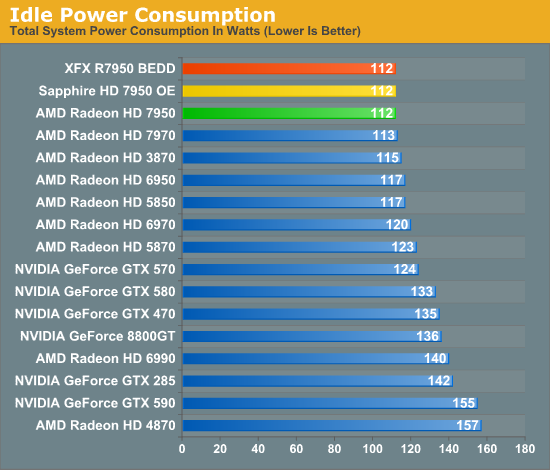
Starting as always with idle power, there aren’t many surprises here. Power islands not only give the 7000 series great idle power characteristics, but they also greatly diminish the difference between GPUs when it comes to idle power consumption. As a result the entire 7950 lineup is at 112W at the wall, consistently 1W below the 7970 and a good 20W below the GTX 580.
The situation with long idle power is much the same. As AMD’s ZeroCore power technology effectively powers down all the workhorse components of the GPU, the only thing left is a small constant load from the bus controller, giving us 103W on both the 7970 and 7950.
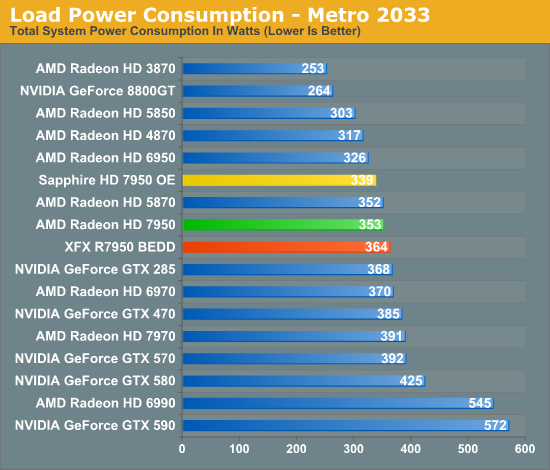
Meanwhile it’s under load that the physical performance attributes of the 7950 really begin to shine. Compared to the GTX 580, our 7950 equipped testbed draws 72W less at the wall; the performance advantage we saw in Metro earlier makes this all the more impressive. The 7950 also pulls less power than the 7970 here as we’d expect, leading to a difference of 38W at the wall.
As for our two partner cards, the Sapphire does particularly well here thanks to its very low VID, while the XFX does a bit worse than the reference 7950, likely due to its stock VID coupled with the factory overclock.
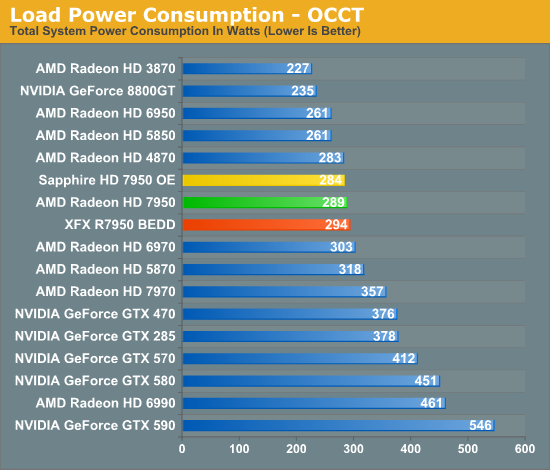
Under OCCT our 7950 cards begin to clump together in spite of their differences. With the reference 7950 at 289W, the Sapphire and XFX cards pull 5W less and 5W more respectively. It’s interesting to note here that as with the 7970 compared to the 6970, the 7950 is pulling more power than the 6950 even though both cards should have the same PowerTune limit. In practice it’s clear that the 7950 is more power hungry than the 6950 despite the PowerTune limit, so this needs to be taken into account accordingly.
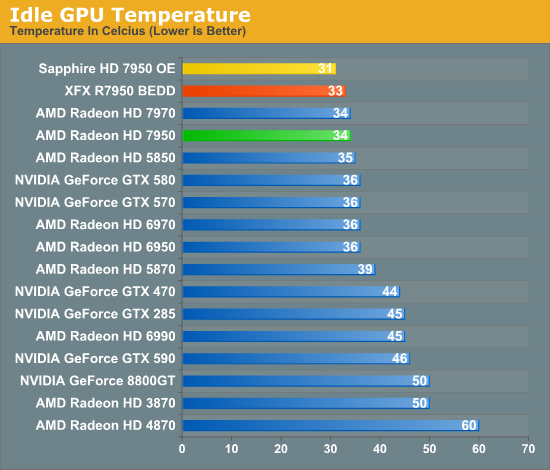
As the use of power islands has brought down the idle power consumption, so has it brought down idle temperatures. The 7970 already did well here and the reference 7950 does similarly well, while the open air coolers on the XFX and Sapphire cards take this one step further, pulling temperatures down to 33C and 31C respectively.
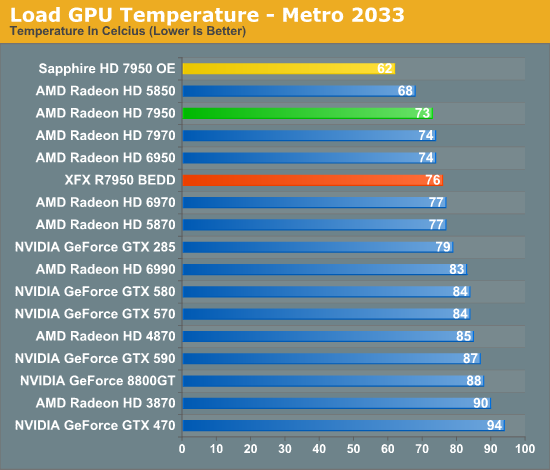
Meanwhile load temperatures are a mixed bag among the 7950s, and it’s not all good. Starting with the Sapphire 7950, we have an open air card with a very low VID that’s performing as we’d expect. The Sapphire card is extremely cool here, and this kind of gap is consistent with other near-200W cards we’ve seen in the past. Elsewhere, in the middle is the reference 7950, which is using AMD’s fully exhausting blower; this pushes almost all the heat outside of our case, but it does keep temperatures higher, and in this case very close to the 7970.
Finally we have the XFX card, which is the odd man out. The R7950 BEDD is an open air cooler and we’d expect performance closer to the Sapphire card, not performance worse than the reference 7950.

Under OCCT the results closely mirror what we saw with under Metro. The Sapphire is well in the lead among the 7950s, followed by the reference and XFX cards. With virtually every other card pushing 80C or higher, the 7950s are in good company here, particularly compared to the 88C GTX 580 due to the lack of comprehensive power throttling on NVIDIA’s part.
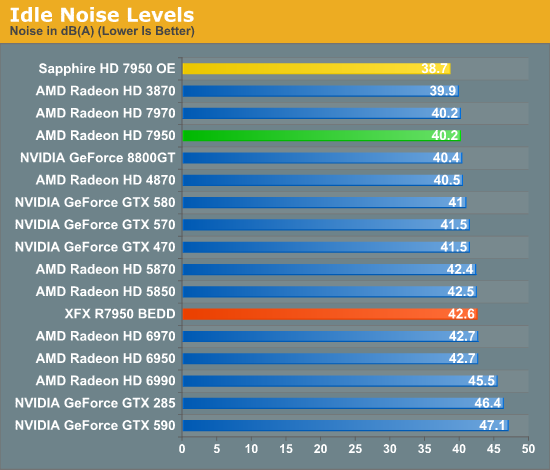
Last but not least we have our look at noise. The 7970’s cooler was already doing quite well at 40.2dB, but Sapphire takes this one step further with their open air cooler, bringing their idle noise down to 38.7dB. XFX on the other hand doesn’t fare as well, as their Double Dissipation cooler can’t rev down quite enough, coming in louder than the reference 7950 at 42.6dB.

It’s looking at load noise that particularly drives home the potential of the Sapphire 7950. Sapphire has exploited their open air cooler for all it's worth, and as a result it’s quieter under load with Metro than half our cards are at idle—41.3dB is only 0.3dB louder than the GTX 580 at idle, never mind the other 7950s. The XFX meanwhile fares really, really poorly here for an open air cooler. This doesn’t appear to be a matter of an aggressive fan profile as we’ve already seen that its temperatures are close to the reference 7950, so there’s more going on here.

Even under OCCT the Sapphire 7950 still only hits 42.8dB, a particularly impressive showing when you consider that AMD’s reference 6900 series cards idle at 42.7dB. It’s not a silent card, but for most practical purposes it’s damn close. Meanwhile the XFX 7950 again fares poorly, coming in at 56.8dB. This is still quieter than the GTX 580 in this case, but it’s clearly disappointing.
Wrapping things up, as we stated in our introduction the vast selection of 7950s means that there’s going to be a wide range of performance for 7950 cards, and these results drive home the point nicely. The Sapphire 7950 simply gushes potential—not only is it a factory overclocked card, but it gives off so little heat and noise compared to anything else in its performance class that it’s unrivaled. Much of this no doubt is due to the extremely low VID of our sample and I strongly suspect that this a better voltage than the bulk of Sapphire 7950s can actually hit, so our results are most likely better than average. Still, even with more voltage there’s still plenty of thermal and acoustic headroom for the Sapphire 7950 to work with, so it should still be a well performing card regardless.
Overall it’s results like what we’ve seen with the Sapphire that are a large part of why AMD’s partners are strongly favoring open air coolers. But with that said, that potential can only be reached in a case with good airflow, meaning that the Sapphire 7950 (or any other open air 7950 for that matter) is likely a poor choice for a cramped case. Furthermore all of these open air cards are poor choices for CrossFire if they need to be directly adjacent to each other. A lot of boards offer usable PCIe x16 slots farther away from their first x16 slot, but this is not the case for all boards. Ultimately the lack of 7950 cards using a fully exhausting blower is definitely going to limit the CrossFire potential of the 7950.
Finally, we have the XFX 7950 BEDD. The 7970 BEDD was a very impressive card; the 7950 BEDD is not. It’s not possible to completely isolate any specific reason for the 7950 BEDD’s poor performance, but the most likely factors are the GPU quality and the ability of the card to transfer heat between the GPU and heatsink. With regards to quality, if the Sapphire 7950 has among the best 7950 GPUs then the 7950 BEDD has an average GPU if not worse; 1.093v is the same as our reference cards, but there’s still room for quite a bit of variance. Whereas when we’re looking at heat transfer we have to look at the much smaller vapor chamber the 7950 BEDD uses compared to the 7970 BEDD, along with what at first glance looks like too much thermal paste.
Given our temperature and power consumption data we’re heavily favoring the heat transfer theory; the 7950 BEDD just isn’t very good at transferring heat from the GPU. This is not to say that the 7950 BEDD is a bad card—our results are reasonable for a 200W card—but we’ve seen much better in the 7970 BEDD, never mind the other 7950 cards.










259 Comments
View All Comments
chizow - Wednesday, February 1, 2012 - link
Sorry, but this is incorrect. Nvidia and AMD are direct competitors when it comes to GPUs so relative performance directly influences price.This is why AMD cannot sell CPUs for more than $200. They don't have anything faster than Intel's 10th+ fastest processors (spread over 2-3 generations, its pretty sad actually), so they can't just price Bulldozer at $1000 by slapping an X on it and expect to sell any.
There is a ceiling on the prices they can charge however due to economic and external factors like price elasticity of demand, disposable income, GDP, competing products (consoles etc) so within that construct, AMD and Nvidia have to price their products to make them most attractive to prospective buyers.
They know exactly what % of the market will bite at each price and performance tier using their own gathered market research as well as independent firms like Peddie etc. $400+ is high-end enthusiast, in order to price here, you have to be the top dog, or the 2nd tier. The top dog sets the table for every other GPU, it doesn't matter who makes it.
Historically, this next-gen top dog has shifted the price and performance metric for all next-gen GPUs because the market expects and demands it. That's just progress. Tahiti brings nothing to the table in this regard, its performance is incremental but its pricing just maintains the status quo.
The problem is Tahiti's pricing indicates the GTX 580 was the target it was shooting for, the problem is, they should've been taking aim at Kepler.
JNo - Thursday, February 2, 2012 - link
chizow - the new pirks?TerdFerguson - Tuesday, January 31, 2012 - link
Chizow is right, you guys are wrong. Get over it.Consumer electronics are supposed to get cheaper AND faster at tremendous rates. In failing to improve their price/performance ratio over a couple of generations, AMD has failed. NVidia is failing pretty badly right now, too, but since this is an AMD release, AMD is getting the flack at the moment. If you apply AMD's pricing model to any other consumer electronics product, it becomes very evident that things are very broken. Would you pay $4k for a Ivy Bridge CPU, because IB > SB > Core2 > Core > P4 > P3 > P2 > Pentium > 486 > etc, and a better chip must always command a price premium? Doh, of course you wouldn't.
mdlam - Tuesday, January 31, 2012 - link
Pricing is determined and adjusted based on the law of efficient markets. the 580 is 500 dollars only because people are still willing to pay for it, not because of Chizow's ridiculous theory that companies conspire these fabulous schemes to trick people out of their money. So based on this existing market of people willing to pay 500 dollars for gtx580 performance benefits, AMD is going to TAKE those customers away by giving more for less, or more for more in a linear price/performance scale. It's just how markets work, prices don't revolve around these God-like rules of tier1, tier2, tier3. Guess what, AMD is right, because these cards right now are selling higher than the $550 retail price. They should have priced it at $650!mdlam - Tuesday, January 31, 2012 - link
And there is no flawed pricing model to AMD that would end up with a slippery slope of $4k for an Ivy bridge. Prices = aggregate buying desire of the market. All markets usually hit a ceiling price for an item, no matter what it is. Some people have a high ceiling, some people have a low ceiling, its not anyone's fault, its just the fact of life. Any company, AMD or NVIDIA, or INTEL, will price to sell to people with higher ceilings, and when demand is met, lower price to increase adoption from folks with lower ceilings.chizow - Wednesday, February 1, 2012 - link
Sorry, not in this market.If you think this is OK, there would never be any progress in the semiconductor market. Its not like we're talking cars here where a new model year means a few minor upgrades.
With GPUs, CPUs and any other semiconductor, you expect FASTER performance at the SAME prices or CHEAPER prices. That's called progress.
The law of efficient markets would tell you if you bought a GTX 580 14 months ago, you made the right call. Buying today, you're setting yourself up for some heartache, but more probably, you're kicking yourself for waiting.
Arnir69 - Friday, February 3, 2012 - link
I'm really disappointed with 7950 too, it's a little bit better than 580 but not enough to justify a such a long wait, it's performance is well short of expectation in BF3.hyperdoggy - Tuesday, January 31, 2012 - link
While I'm not in favor of the prices AMD has set for the new cards, you do realize that Nvidia has never prices their cards low right? A quick price check history will show you since the FX day Nvidia has priced their card to sell your kidney. It was the tnt days that Nvidia did a price favor vs their competitors. I bet you my right kidney(i sold my left one for a 8800gtx for $650 day 1 of lunch) that Kepler will be no different, regardless of what its performance will be.I never got the fanboy aspect of things, you see gamers that can calculate min-max fps better than most math majors yet somehow only see red or green when the numbers are laid out right in front of them. I'm shame to say i'm old enough to been around from the voodoo days, i went to Voodoo, Nvidia, Ati, Nvidia, Ati, Nvidia, and now name AMD for more than i can remember. Go for what's best at the time you need an upgrade. Stop making yourself colored hulk when your team doesn't have a product to be competitive.
SlyNine - Tuesday, January 31, 2012 - link
Yea and the 8800GTX kicked stomped the crap out of the competition. This is just a bump up, and kick stomp prices.Plus this is AMD not Nvidia. Where is the 5870, the 9700pro. This is closer to a 5800Ultra or a 2900XT. Of course those cards at least had some real competition in the form of a 8800GTX and 9700pro.
If the 8800GTX and 9700pro would have only increased performance as much as say the 6970 or 580GTX ( compared to their previous cards 5870/480) then the analogy would truly work and the 7970 would basicly be the 2900XT/5800Ultra of its day.
chizow - Tuesday, January 31, 2012 - link
Actually if you look at recent pricing history, you'd see Nvidia has kept their flagship pricing in-line and much lower than what we are seeing here with SI, despite the fact Nvidia had the leading part for that generation in both cases with the GTX 480 and GTX 580.Both of those parts launched at $500 and were faster than AMD's competing same-generation part. If Nvidia did the same as AMD, the 580 would've been priced at $550-600 for that 10-15% performance bump over the 480, but they kept their pricing constant while increasing performance. As I stated earlier, AMD definitely had a hand in this when they undercut the GTX 280 so badly in 2008, but Nvidia did learn their mistake and has not raised the pricing metric since.
Now Nvidia does have a decision to make. If they beat SI with Kepler as expected, they can go with AMD's pricing which will again, make no sense. Or they can stick to their historical price/performance model and make AMD look really bad just as AMD did to them 3 1/2 years ago.